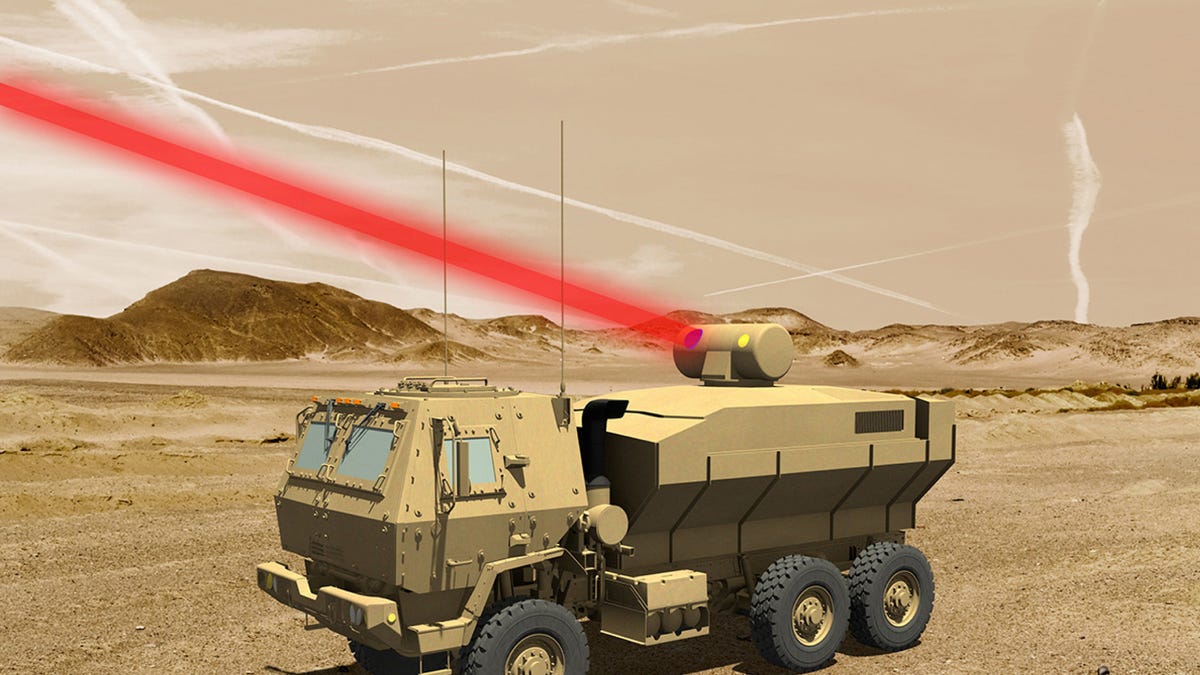Laser weapons see some light progress
Both the US Army and defense contractor Lockheed Martin talk up their advances in directed energy.

This is how Lockheed envisions its laser weapon being put to use.
A laser hits its target in an instant. Getting to a practical laser weapon can feel like it's taking an eternity.
This week brought signs of progress, one from the US Army and the other from defense contractor Lockheed Martin. Both involved laser weapons still a long way from being battlefield-ready.
The more momentous news came from Lockheed, which on Thursday said that it has wrapped up development and testing of a nearly 60-kilowatt fiber laser for the Army. That's double the power of a system the company showed off two years ago that it said disabled a truck from a mile away.
Those Lockheed systems got their juice by combining multiple lower-power fiber-optic lasers to produce a single, higher-power beam, a method that promises a relatively straightforward path to ever more powerful weapons. In the case of Lockheed's newer laser, the output was a single beam of 58KW, what the company called "a world record for a laser of this type."
Lockheed did not immediately provide additional details on the new laser.
Research into laser weapons -- part of a larger field known as directed energy -- stretches back decades, but so far has yielded little more than prototypes and the occasional big-budget, high-profile flop. The attraction is easy to understand: A laser beam travels at the speed of light, far faster than missiles or bullets, and with incredibly precise targeting. Proponents talk of an ammo supply that's cheap and almost limitless -- so long as there's a handy source of electricity.
All the branches of the military see laser weapons in their future, on a modest scale. The Navy has tried out systems that can disable the engines on small attack boats, and has even deployed a laser-weapon-equipped ship to the Persian Gulf. The Air Force envisions lasers on special operations aircraft.
But laser systems are complex and delicate, unlike the rugged gear that a military depends upon to work reliably in harsh, dangerous conditions. The laser beams themselves would be subject to atmospheric conditions less favorable than those found in labs or test environments.
That's where the Army's news this week comes in. Its Space and Missile Defense Command on Friday reported the results of some real-world testing of a vehicle-mounted laser weapon at the White Sands Missile Range in New Mexico.
Over five days of trials as February turned to March, the Mobile Expeditionary High Energy Laser 2.0 -- a testbed system mounted on the chassis of a Stryker armored vehicle -- had to engage with quadcopters and small fixed-wing unmanned aircraft. At just 5KW of power, it was a popgun compared with the system Lockheed just wrapped up testing.
The MEHEL 2.0 just completed a trial by fire at the White Sands Missile Range.
But the MEHEL 2.0, also a fiber laser, proved its worth, according to the Army.
"We learned the 5KW laser was able to defeat the targets," said Adam Aberle, the SMDC official overseeing the project, in a statement. "We were able to verify and show that we could put a radar and a laser on a platform so it could self-cue to targets and that was very successful."
It's the sort of testing that's been happening off and on for years.
Aberle also acknowledged "some limitations in the system," saying that "we have plans to correct those deficiencies for future activities."
The new Lockheed system, meanwhile, will be making its way to the Army, with much work planned for the coming months. It'll be integrated onto a larger vehicle than the Stryker, and its White Sands testing could happen in the middle of the Army's fiscal year 2018.
Eventually, the Army is aiming for even higher power levels.
"Our ultimate goal is to have a 100KW laser on a vehicle. That's what we're going for," said John Cummings, an SMDC spokesman. "We have to take baby steps to get there."
CNET Magazine: Check out a sampling of the stories you'll find in CNET's newsstand edition.
Crowd Control: A crowdsourced science fiction novel written by CNET readers.

